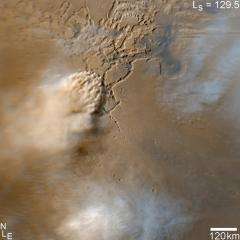January 25, 2010 report
Acoustic levitation could be used on Mars

(PhysOrg.com) -- The presence of fine dust on the Moon and Mars may present problems for explorers, such as coating solar panels, penetrating seals and interfering with machinery. Human explorers would also be endangered if there was a possibility of inhaling the extremely fine dust particles. Now scientists at the University of Vermont are considering a novel solution: acoustic levitation.
Finding ways of dealing with the fine dust is a high priority because the problems it can cause could drastically affect any long-term exploration. The thin atmosphere on Mars means dust particles are not as rounded as they would be on Earth and can remain quite sharp and abrasive, and they have a high electrostatic charge, which means the fine dust clings to everything and can penetrate space suit air locks, and make solar panels inoperable.
The researchers from the Department of Physics and Materials Science Program carried out a feasibility study to develop an acoustic dust removing system for use in space stations or habitations on the Moon or Mars. They found a high-pitched (13.8 kHz, 128 dB) standing wave of sound emitted from a 3 cm aperture tweeter and focused on a reflector 9 cm away was strong enough to dislodge and move extremely fine (<2 µm diameter) dust particles on the reflector surface. The sound waves overcome the van der Waals adhesive force that binds dust particles to the surface, and creates enough pressure to levitate the dust, which is then blown away.
The team tested the system on a solar panel coated with mock lunar and Martian dust. The output of the clean panel was 4 volts, but when coated with dust it produced only 0.4 volts. After four minutes of acoustic levitation treatment the output returned to 98.4% of the maximum.
Study co-author Junrun Wu said acoustic levitation is not new, but this is the first time it has been considered for applications away from Earth. The technology is cheap and uses readily found parts, but there is one enormous problem: it will only work when it is sealed inside a space station or other habitation. It will not work where there is no atmosphere (such as the moon) or where the atmosphere is low pressure and thin (such as Mars) because sound is a pressure wave that travels through the air. This limits its usefulness because inside an enclosed space station there would be relatively little dust, and probably other readily-available means of removing it without resorting to acoustic levitation.
The paper is published in the Journal of the Acoustical Society of America in January.
More information: Dislodgement and removal of dust-particles from a surface by a technique combining acoustic standing wave and airflow. J. Acoust. Soc. Am. Volume 127, Issue 1, pp. 45-50 (January 2010) dx.doi.org/10.1121/1.3268507
© 2010 PhysOrg.com




















